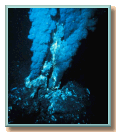
Image courtesy NOAA Central Library |
Meanwhile research down here on Earth revolutionized our view of where life might have existed--and perhaps might still exist!--on Mars: they discovered life in places where conventional scientific wisdom said no creatures could exist. Underwater explorers searching for deep sea volcanoes found hot gases venting out of cracks deep under the ocean. Close by these "black smokers" were colonies of organisms, including bright red tube-like critters. Other researchers found there were microbes thriving in the boiling volcanic pools of places like Yellowstone National Park. Even in the deep cold ice of the South Pole, a place without sunlight for more than half the year, some bacteria had found a way to survive! As far as 2 miles down below Earth’s surface, other researchers found simple kinds of life. These creatures were called "extremophiles" and they seemed able to survive in very hot or very cold places, and environments where the Sun never shone--just about anywhere, in fact, where there was liquid water and some kind of energy to drive life’s processes. Perhaps, space scientists wondered, if Mars was once much warmer and wetter, life might have begun, and retreated deep down as Mars cooled and its atmosphere thinned and faded. Perhaps there are even "hot spots", oases and geysers somewhat like those in Yellowstone, where life might have retreated. Maybe it lives in the permafrost and ice down below the rust-red rocks.
|
